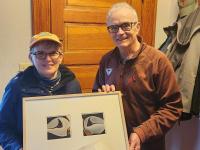So long winter, hello spring (official arrival, 6:45 p.m. this evening)
Lots of celestial activity March 20. It’s the calendar’s first day of spring, there is a partial solar eclipse, and the moon is just moving away from its periodic close position to earth in its orbit. The Spring Equinox formally occurs at 6:45 p.m. this evening in Maine. Like Spring 2014, temperatures are slow in warming, but the sun is strong and bright today, with a high of 35 degrees in the the forecast. (There is snow on the horizon for Saturday, but we don’t need to talk about that now.)
Hope rides in on the equinox, the great equalizer. This evening, earth’s northern and southern hemispheres will be equally illuminated, and then the days will get longer and longer, until late June, when the skies stay magically bright way past the dinner hour. Make way for those short, sweet nights of July, when the last glimpse of daylight is visible until 10 p.m. and the birds are singing at 4 a.m. — if not all night long.
Spring has returned. The Earth is like a child that knows poems.
— Rainer Marie Rilke
“There are only two times of the year when the Earth's axis is tilted neither toward nor away from the sun, resulting in a ‘nearly’ equal amount of daylight and darkness at all latitudes,” according to the National Weather Service. “These events are referred to as equinoxes.The word equinox is derived from two Latin words - aequus (equal) and nox (night). At the equator, the sun is directly overhead at noon on these two equinoxes. The nearly equal hours of day and night is due to refraction of sunlight or a bending of the light's rays that causes the sun to appear above the horizon when the actual position of the sun is below the horizon. Additionally, the days become a little longer at the higher latitudes (those at a distance from the equator) because it takes the sun longer to rise and set. Therefore, on the equinox and for several days before and after the equinox, the length of day will range from about 12 hours and six and one-half minutes at the equator, to 12 hours and 8 minutes at 30 degrees latitude, to 12 hours and 16 minutes at 60 degrees latitude.”
Spring is nature's way of saying, 'Let's party!'
— Robin Williams
This technically means that we have been enjoying the progression to spring for the last few days, even while temperatures hovered above zero in the early morning hours.
At the University of Southern Maine’s planetarium, they are a little more poetic. This is what they wrote last spring, but we will repeat: “How can one not award the gold to Spring's first day?! Astronomical winter has finally ended and spring begins! This transition from Hell's chambers to Heaven's pastures occurs precisely at 6:45 EDT. Astronomically, the Sun's apparent orbital path, the ecliptic, intersects the Celestial Equator. The Sun then ascends above the Celestial Equator and will remain north of it until the autumnal equinox.”
The Old Farmer’s Almanac is predicting a wetter and warmer April and May in the Northeast.
“April and May will be warmer and wetter than normal in the north and much warmer and drier than normal in the south,” it said.
But today is perfect for getting outside and enjoying the last of Ole Man Winter. Adios, you cranky bear.
Event Date
Address
United States






















